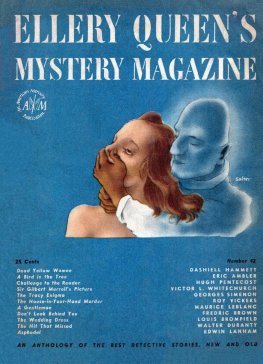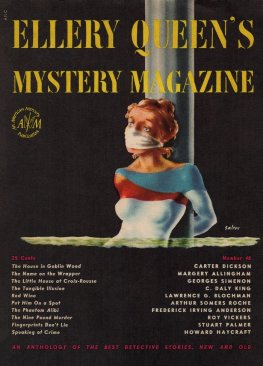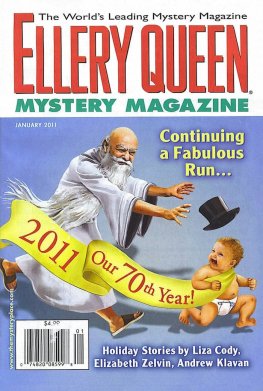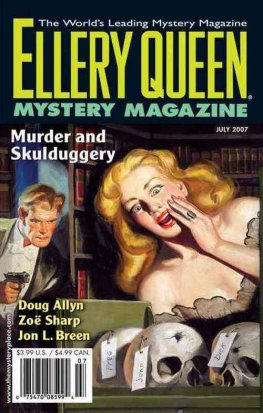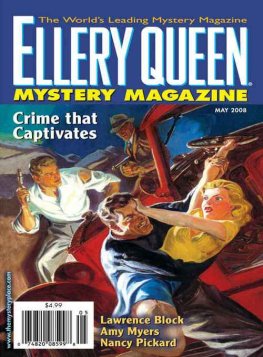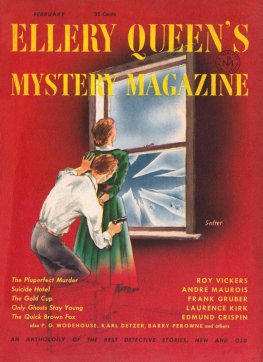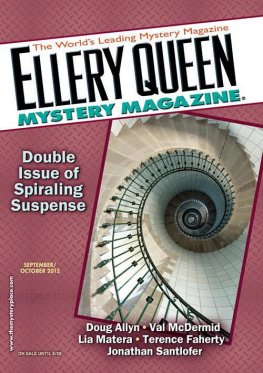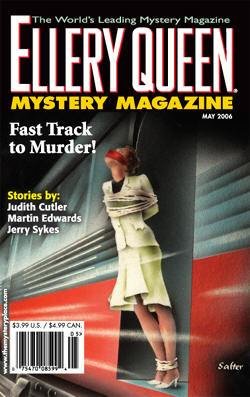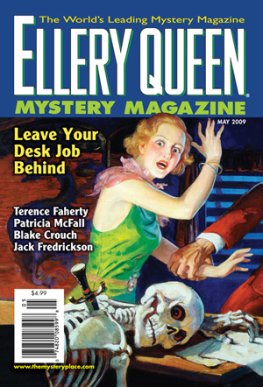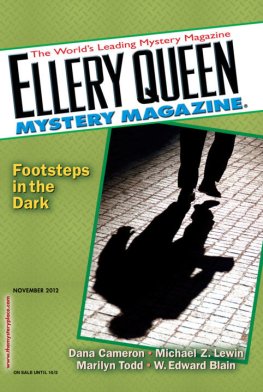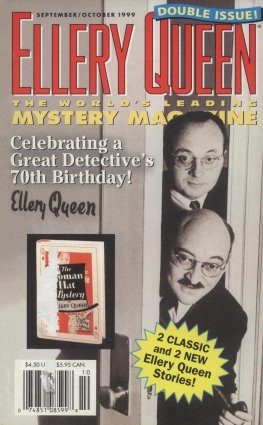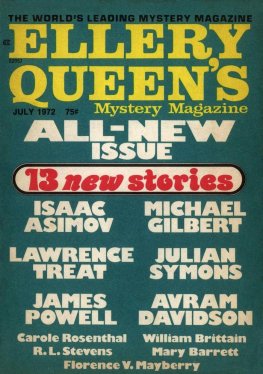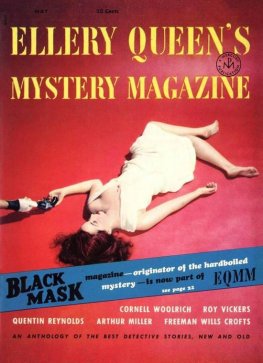Erik Embler - Ellery Queen’s Mystery Magazine. Vol. 9, No. 42, May 1947
Here you can read online Erik Embler - Ellery Queen’s Mystery Magazine. Vol. 9, No. 42, May 1947 full text of the book (entire story) in english for free. Download pdf and epub, get meaning, cover and reviews about this ebook. City: New York, year: 1947, publisher: The American Mercury, genre: Detective and thriller. Description of the work, (preface) as well as reviews are available. Best literature library LitArk.com created for fans of good reading and offers a wide selection of genres:
Romance novel
Science fiction
Adventure
Detective
Science
History
Home and family
Prose
Art
Politics
Computer
Non-fiction
Religion
Business
Children
Humor
Choose a favorite category and find really read worthwhile books. Enjoy immersion in the world of imagination, feel the emotions of the characters or learn something new for yourself, make an fascinating discovery.
- Book:Ellery Queen’s Mystery Magazine. Vol. 9, No. 42, May 1947
- Author:
- Publisher:The American Mercury
- Genre:
- Year:1947
- City:New York
- Rating:4 / 5
- Favourites:Add to favourites
- Your mark:
- 80
- 1
- 2
- 3
- 4
- 5
Ellery Queen’s Mystery Magazine. Vol. 9, No. 42, May 1947: summary, description and annotation
We offer to read an annotation, description, summary or preface (depends on what the author of the book "Ellery Queen’s Mystery Magazine. Vol. 9, No. 42, May 1947" wrote himself). If you haven't found the necessary information about the book — write in the comments, we will try to find it.
Erik Embler: author's other books
Who wrote Ellery Queen’s Mystery Magazine. Vol. 9, No. 42, May 1947? Find out the surname, the name of the author of the book and a list of all author's works by series.
Ellery Queen’s Mystery Magazine. Vol. 9, No. 42, May 1947 — read online for free the complete book (whole text) full work
Below is the text of the book, divided by pages. System saving the place of the last page read, allows you to conveniently read the book "Ellery Queen’s Mystery Magazine. Vol. 9, No. 42, May 1947" online for free, without having to search again every time where you left off. Put a bookmark, and you can go to the page where you finished reading at any time.
Font size:
Interval:
Bookmark:
Ellery Queens Mystery Magazine. Vol. 9, No. 42, May 1947

Dead Yellow Women
by Dashiell Hammett
Dashiell Hammett is branching out. True, he has not written a novel since THE THIN MAN which was published thirteen years ago (its hard to believe, isnt it, that THE THIN MAN first appeared so long ago?), but the author of such fabulous detective novels as THE MALTESE FALCON and THE GLASS KEY can rest on his laurels for a long, long time especially if his success in so-called supplementary fields keeps increasing with the years. For surely Mr. Hammett has performed the literary hat trick with a vengeance: his books continue to sell in reprint editions of all prices; his movie credits are still associated with Class A productions; and his radio record is reaching an all-time high at the time of this writing there are no less than three Hammett shows on the air (The Thin Man, The Fat Man, and Sam Spade) and rumors are flying that The Continental Op will join his brothers-of-the-blood on the ether any week now. And still Dashiell Hammett is branching out. From the grapevine comes the report that Mr. Hammett is writing his first play for Broadway. That is good news indeed! Hammett has it in him to write a smash hit remember his powerful screenplay of Lillian Hellmans WATCH ON THE RHINE? Will Mr. Hammett write a serious play? He can do it. Or will he stick to his first love detection-and-melodrama? Selfishly, we hope Mr. Hammett makes his debut as a dramatist in the genre to which he has already made so important a contribution...
It is many years since Mr. Hammett has written a new short story. He once told your Editor he might never go back to the short-story form. We think he will, and until that happy day we shall continue to unearth Mr. Hammetts buried treasures of the past and bring you such unknown stories as the Continental Ops early adventure titled Dead Yellow Women.
Copyright 1925, by Pro-Distributors Publishing Co., Inc.
She was sitting straight and stiff in one of the Old Mans chairs when he called me into his office a tall girl of perhaps twenty-four, broad-shouldered, deep-bosomed, in mannish grey clothes. That she was Oriental showed only in the black shine of her bobbed hair, in the pale yellow of her unpowdered skin, and in the fold of her upper lids at the outer eye-corners, half hidden by the dark rims of her spectacles. But there was no slant to her eyes, her nose was almost aquiline, and she had more chin than Mongolians usually have. She was modern Chinese-American from the flat heels of her tan shoes to the crown of her untrimmed felt hat.
I knew her before the Old Man introduced me. The San Francisco papers had been full of her affairs for a couple of days. They had printed photographs and diagrams, interviews, editorials, and more or less expert opinions from various sources. They had gone back to 1912 to remember the stubborn fight of the local Chinese mostly from Fokien and Kwangtung, where democratic ideas and hatred of Manchus go together to have her father kept out of the United States, to which he had scooted when the Manchu rule flopped. The papers had recalled the excitement in Chinatown when Shan Fang was allowed to land insulting placards had been hung in the streets, an unpleasant reception planned. But Shan Fang had fooled the Cantonese. Chinatown had never seen him. He had taken his daughter and his gold presumably the accumulated profits of a life-time of provincial misrule down to San Mateo County, where he had built what the papers described as a palace on the edge of the Pacific. There he had lived and died in a manner suitable to a Ta Jen and a millionaire.
So much for the father. For the daughter this young woman who was coolly studying me as I sat down across the table from her: she had been ten-year-old Ai Ho, a very Chinese little girl, when her father had brought her to California. All that was Oriental of her now were the features I have mentioned and the money her father had left her. Her name, translated into English, had become Water Lily, and then, by another step, Lillian. It was as Lillian Shan that she had attended an eastern university, acquired several degrees, and published a book on the nature and significance of fetishes, whatever all that is or are.
Since her fathers death, in 1921, she had lived with her four Chinese servants in the house on the shore, where she had written her first book and was now at work on another. A couple of weeks ago, she had found herself stumped, so she said had run into a blind alley. There was, she said, a certain old cabalistic manuscript in the Arsenal Library in Paris that she believed would solve her troubles for her. So she had packed some clothes and, accompanied by her maid, a Chinese woman named Wang Ma, had taken a train for New York, leaving the three other servants to take care of the house during her absence.
On the train between Chicago and New York, the key to the problem that had puzzled her suddenly popped into her head. Without pausing even for a nights rest in New York, she had turned around and headed back for San Francisco. At the ferry here she had tried to telephone her chauffeur to bring a car for her. No answer. A taxicab had carried her and her maid to her house. She rang the door-bell to no effect.
When her key was in the lock the door had been suddenly opened by a young Chinese man a stranger to her. He had refused her admittance until she told him who she was. He mumbled an unintelligible explanation as she and the maid went into the hall.
Both of them were neatly bundled up in some curtains.
Two hours later Lillian Shan got herself loose in a linen closet on the second floor. Switching on the light, she started to untie the maid. She stopped. Wang Ma was dead. The rope around her neck had been drawn too tight.
Lillian Shan went out into the empty house and telephoned the sheriffs office in Redwood City.
Two deputy sheriffs had come to the house, had listened to her story, had poked around, and had found another Chinese body another strangled woman buried in the cellar. Apparently she had been dead a week or a week and a half; the dampness of the ground made more positive dating impossible. Lillian Shan identified her as another of her servants Wan Lan, the cook.
The other servants Hoo Lun and Yin Hung had vanished. Of the several hundred thousand dollars worth of furnishings old Shan Fang had put into the house during his life, not a nickels worth had been removed. There were no signs of a struggle. Everything was in order. The closest neighboring house was nearly half a mile away. The neighbors had seen nothing, knew nothing.
Thats the story the newspapers had hung headlines over, and thats the story this girl, sitting very erect in her chair, speaking with businesslike briskness, told the Old Man and me.
I am not at all satisfied with the effort the San Mateo County authorities have made to apprehend the murderer or murderers, she wound up. I wish to engage your agency.
Have you any idea of your own on the murders, Miss Shan? I asked.
I have not.
What do you know about the servants the missing ones as well as the dead?
I really know little or nothing about them. She didnt seem very interested. Wang Ma was the most recent of them to come to the house, and she has been with me for nearly seven years.
Dont you know where they came from? Whether they have relatives? Whether they have friends?
No, she said. I did not pry into their lives.
The two who disappeared what do they look like?
Hoo Lun is an old man, quite white-haired and thin and stooped. He did the housework. Yin Hung, who was my chauffeur and gardener, is younger, about thirty years old, I think. He is quite short, even for a Cantonese, but sturdy. His nose has been broken at some time and not set properly. It is very flat, with a pronounced bend in the bridge.
Font size:
Interval:
Bookmark:
Similar books «Ellery Queen’s Mystery Magazine. Vol. 9, No. 42, May 1947»
Look at similar books to Ellery Queen’s Mystery Magazine. Vol. 9, No. 42, May 1947. We have selected literature similar in name and meaning in the hope of providing readers with more options to find new, interesting, not yet read works.
Discussion, reviews of the book Ellery Queen’s Mystery Magazine. Vol. 9, No. 42, May 1947 and just readers' own opinions. Leave your comments, write what you think about the work, its meaning or the main characters. Specify what exactly you liked and what you didn't like, and why you think so.

